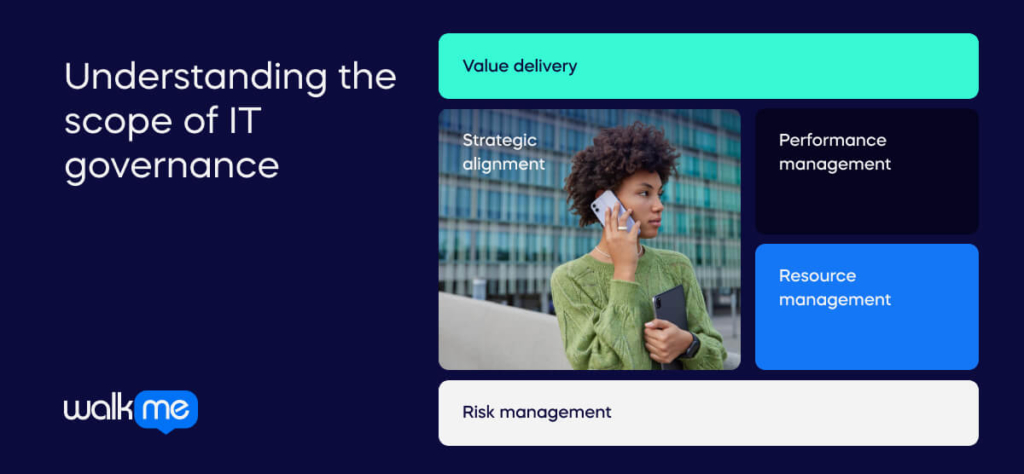IT governance is a formal framework that recommends policies, processes, and capability decisions for all aspects of information technology (IT) management.
Companies rely on it to improve their strategic use of technology, mitigate risks, and comply with regulations. This leads to more efficient and trusted technology investments.
The need for up-to-date IT governance is a natural next step for today’s companies. Technology impacts continue to reshape the relationship between business and technology into one of ongoing innovation. This has led many companies to begin their digital transformation journeys.
AI is changing how businesses work. Its ability to uncover hidden patterns in data and automate tedious tasks is changing the game. At the same time, cloud computing provides tools that enable businesses to operate virtually anywhere.
Gartner states that cloud spending driven by emerging technologies is becoming mainstream.
This article will help readers navigate IT governance. We’ll explore its definition, importance, and its role in driving strategic technology choices. We’ll also share a list of the top IT governance frameworks that are trusted and relied on across industries.
What is IT governance?
IT governance establishes clear guidelines and procedures for the end-to-end management of a company’s IT.
These guidelines delineate the secure and efficient use of computers, software, and online resources by employees. Additionally, they assist in making informed decisions about purchasing new technology and ensuring compliance with relevant regulations.
A recent study by Gartner predicts that by 2027, attempts to improve how companies use data and analytics (D&A governance) will fail by up to 80%.

Why? Because these attempts often do not focus on solving the company’s most important problems.
As Saul Judah, an expert at Gartner, said, “Through recent crises, such as COVID-19 or increased energy costs, chief data & analytics officers (CDAOs) who successfully helped their organizations navigate through those disruptions, understood the crisis and quickly pivoted D&A to help business leaders address it.”
Why is IT governance important?
Companies collect and store a lot of important information. They must follow strict rules about data privacy, security, and how they report finances.
IT governance falls under the corporate governance umbrella, the system companies use to ensure they follow all these rules.
Oversights in risk management and IT governance can lead to many consequences for companies down the line. Financial institutions’ lack of careful planning, including weak risk management and IT controls, played a role in the 2008 financial crisis.
In response, the Dodd-Frank Wall Street Reform and Consumer Protection Act was passed in 2010. This law created a new Consumer Financial Protection Bureau (CFPB) agency to regulate unfair, deceptive, or abusive practices in the financial services industry.
Stricter rules and regulations like these are becoming increasingly necessary. In the past, there wasn’t always a clear system for handling sensitive information. This lack of transparency is a big reason laws like Dodd-Frank and other notable legislation such as Sarbanes-Oxley appear—they’re trying to address weaknesses in how companies handle data as technology use keeps evolving.
Nowadays, almost everything in business relies on technology. Because of this, having a strong IT governance strategy is extremely important.
This plan helps companies use technology in the right way and make sure their investments pay off. Strong IT governance tools gives companies the ability to avoid problems, protect their reputation, and build trust with employees, partners, and everyone across the organization.
Understanding the scope of IT governance

Today’s companies must adopt IT governance frameworks that best suit their risk profile, industry, and organizational needs.
We must examine five major domains to understand how to implement IT governance frameworks and principles.
- Value delivery
This domain thrives in environments focused on measurable results. Companies launching new marketing campaigns or implementing customer relationship management (CRM) software need a framework that links IT investments to specific business objectives.
For example, the framework might require tracking metrics like website traffic, lead generation, and customer satisfaction after a new marketing campaign’s launch. Strong value delivery ensures IT is not just a cost center, but a vehicle for a healthy ROI.
- Strategic alignment
This domain shines in situations where long-term strategy takes center stage. Mergers and acquisitions, for example, require a framework that ensures smooth IT integration between two companies.
The framework would map the long-term business goals of both companies to IT plans. This would ensure that technology investments support the merged organization’s overall strategy.
- Performance management
Fast growth demands an IT governance framework focused on monitoring IT performance. The framework defines clear metrics, such as uptime and performance, that IT teams track. A proactive approach helps identify bottlenecks before they impact business growth, ensuring smooth operations and supporting the company’s rapid scaling.
- Resource management
IT governance relies heavily on resource management for strategically allocating and controlling its assets: hardware, software, and ever-growing cloud services.
This domain ensures these assets are not only efficiently utilized, meaning allocated to meet specific business needs without waste, but also cost-effective. Spending aligns with strategic goals, and cost-optimization measures are actively pursued. Ultimately, resource management guarantees IT assets directly support business initiatives.
Cloud migration amplifies this need. A robust IT governance framework ensures optimal cloud resource allocation and maximizes ROI by choosing the most fitting services and closely monitoring usage
- Risk management
Highly regulated industries, such as finance and healthcare, face a constant barrage of potential threats. They require robust IT governance frameworks, such as COBIT or NIST Cybersecurity Framework to combat these threats. These frameworks provide organizations with a structured approach to identifying and mitigating IT risks.
It asks: “What potential threats could disrupt IT operations?” and “Do we have adequate controls in place to protect our systems and data?“
For example, a healthcare organization might leverage the COBIT framework to implement robust access controls and data encryption measures, ensuring compliance with HIPAA regulations and safeguarding sensitive patient information.
What are the most widely trusted IT governance frameworks?
Now that we’ve explored the key areas of IT governance, let’s examine the most popular frameworks that leading companies use.
Some frameworks focus specifically on managing IT systems. Others offer a broader foundation for making smart technology decisions, managing risks, and ensuring that an organization follows regulations.
- ISO/IEC 38500:2024
The International Organization for Standardization (ISO) created the ISO 38500 framework. It provides a practical toolkit for managing IT and supporting directors and executives in making wise technology choices. The focus of ISO 38500 is primarily on governing IT systems.
ISO 38500 is regularly updated with a set of best practices for organizations. This framework outlines important principles for IT governance. The latest recommendations reaffirm the need to define roles and responsibilities. They also stress the importance of open communication and careful risk evaluation.
- COBIT
COBIT (Control Objectives for Information and Related Technology) is another popular framework for IT governance. Developed by the ISACA, it offers a roadmap outlining objectives and best practices for managing technology.
Unlike frameworks focused on specific IT services such as ITIL, COBIT takes a broader approach to IT governance. It acts as a command center, providing a 360-degree view of all aspects of IT management.
This approach allows organizations to effectively govern their IT function and make IT investments that directly support their strategic goals. COBIT is commonly leveraged by firms that want to optimize technology spending and improve overall performance.
- ITIL
The Information Technology Infrastructure Library (ITIL) addresses a specific challenge – ensuring the delivery of dependable and efficient IT services. Its focus area isn’t on broad IT governance or overarching strategy. Instead, ITIL outlines clear procedures and best practices for the entire IT service lifecycle.
This includes safeguarding IT systems, addressing issues, and designing service delivery. Services must be refined using user input and made available to those who rely on them.
- ISO/IEC 27001:2022
ISO 27001 tackles a critical aspect: information security. This framework provides guidelines for managing information security risks. Like ISO 38500, ISO 27001 is updated regularly. Framework principles focus on protecting sensitive data from cyber threats, unauthorized access, and accidental loss.
ISO 38500 and ISO 27001 work together. 38500 provides the big-picture strategy for managing IT. On the other hand, 27001 focuses on the specific details of keeping information safe. This combination ensures that technology aligns with business goals while remaining secure.
- Governance, Risk & Compliance (GRC) frameworks
While ISO 38500 provides principles for governing IT, GRC frameworks offer broader recommendations. GRC recommendations help organizations manage overall governance, risk, and compliance across the following areas:
- Enterprise-wide risk management
- Financial reporting and controls
- Operational risks
- Legal and regulatory compliance
- IT Governance
GRC frameworks offer methods and best practices that inform financial reporting, legal compliance, and operational processes. A specific example within GRC frameworks is the Risk Management Framework (RMF) by NIST. This framework offers a step-by-step approach to managing security risks in information systems. This is crucial for strong IT governance.
- COSO
Within the realm of GRC frameworks, the COSO framework stands out. COSO (The Committee of Sponsoring Organizations of the Treadway Commission) equips organizations with the tools to identify, assess, and effectively manage enterprise risks.
Like others on this list, the COSO principles broaden the scope of risk management. This approach ensures that any potential threats are addressed across the entire organizational ecosystem.
More importantly, this includes an organization’s ability to assess all risks related to IT governance. COSO principles help firms build a risk-aware culture around their technology infrastructure. Environments where internal controls are implemented and communication of potential risks flow freely.
Technology fuels a constant wave of innovation, driving modern businesses forward. However, in this high-octane environment, IT leaders face the crucial task of ensuring innovation does not come at the expense of security and safety.
A recent Gartner says cyber threats and IT governance reached the top of auditors’ list of concerns in 2023. While most organizations plan to address these security gaps, only 42% feel highly confident in their ability to provide adequate assurance in this area.
IT governance frameworks provide the foundation for this balance. It’s not just about following a checklist; it’s about establishing a framework that safeguards valuable information assets and protects the digital community.
Strong IT governance isn’t optional; it underpins a future where innovation thrives alongside responsible practices. Organizations can navigate the digital arena confidently and securely with dependable IT governance.


